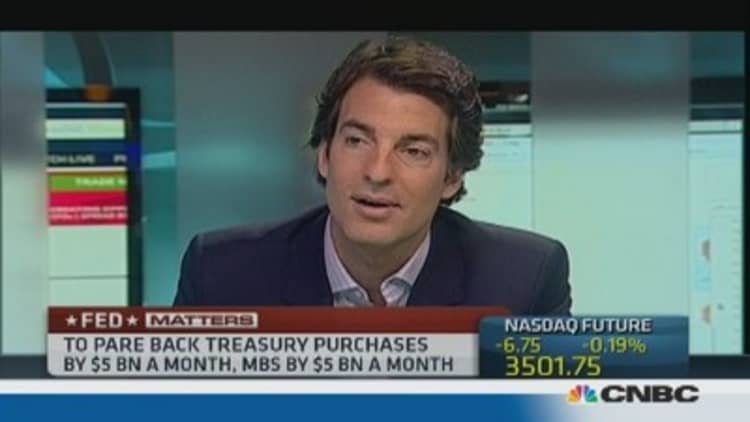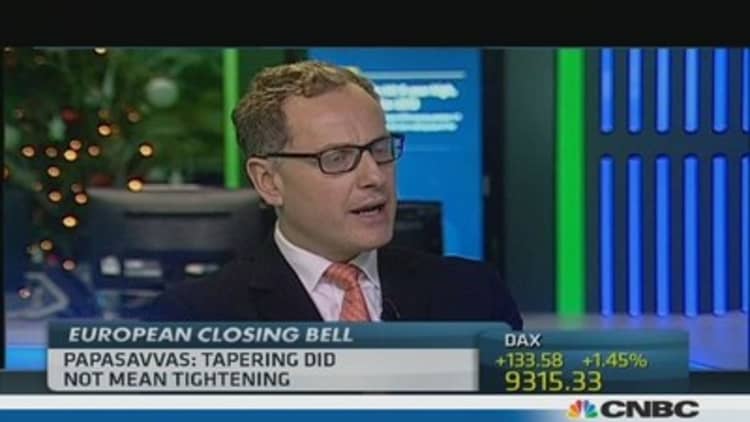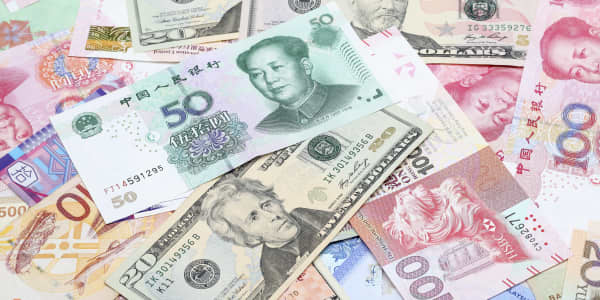They did it. The markets passed the test. U.S. Federal Reserve Chairman Ben Bernanke gave us the "taper" Wednesday and stocks soared higher with Treasury yields also ticking upwards.
Now we're set for a 2014 where yields and stocks push higher in unison, right? Wrong, says Pedro de Noronha, managing partner at hedge fund Noster Capital.
(Read More: Nobel Prize winner warns of US stock market bubble)
"I'm not entirely convinced this move is going to last," Noronha told CNBC Thursday. "The natural reaction when yields go higher is also for stock markets to go lower."
He predicts that the only way bonds can have a good 2014 is if there's a "massive correction" in equities, adding that the wall of money that is expected to be invested in equities at the expense of bond funds is likely to suffer from negative returns in the not too distant future.
In one of the most closely-watched central bank meetings of the year, the Fed announced Wednesday that it would start trimming its monthly asset purchases by $10 billion to $75 billion from January onwards. But to temper the market impact of the move, the Fed said its key interest rate would stay near zero "well past the time" unemployment falls below 6.5 percent.
Global stocks roared higher, even as Treasury yields saw an upward move on the news, resting at 2.9272 percent on Friday morning. Some investors, including Noronha, were left puzzled by this correlation due to a stock valuation method called discounted cash flow (DCF). This is a widely used method that enables analysts to calculate how much a stock is worth.
(Read More: Take cover! Bond market 'hell' could be on the way)

A dollar today isn't worth the same as a dollar in five years' time, and DCF stands by this rule of thumb. The calculation uses many factors, like inflation and a company's ability to borrow, to work out its actual cash flow over a period of time. One of the main factors used in the equation is the yield on a benchmark 10-year Treasury, deemed to be the traditional risk-free rate. So if yields tick higher, the less cash flow a company could have in the future because it would cost them more to borrow. This means their current rating would suffer. And if a current rating decreases to below what its value is on the stock market, then its price could tumble.
"Investors need to realize that almost 50 percent of the earnings growth in the S&P 500 from 2009 to date came from lower interest rates," Noronha told CNBC. "That tide has now shifted, and those tailwinds turned into headwinds, making 2014 a tougher year for the equity markets."
Noronha admits that this is "theoretical" and stocks have a tendency to fly higher anyway, like they did after Wednesday's decision. But Noronha's voice adds to a chorus of calls that 2014 is going to a difficult year for Treasurys and equities.
(Read More: US recession is nigh...and the Fed can't stop it: SocGen bear)
Sandy Jadeja, chief market strategist at SignalPro told CNBC Friday that he's concerned going into 2014 and predicts a very sharp sell-off.
"I think we're going to see the (Dow Jones) shave off 4,700 points. It may not do it in 2014 all in one go," he said.

Kit Juckes, global head of foreign exchange strategy at Societe Generale said in his 2014 predictions on Thursday that he expects the to initially rally after the Fed "tapered" its bond purchases, but for this to quickly reverse by the middle of 2014.
(Read More: Stand by…a hefty drop's on the way: Nomura's Janjuah)
"By mid-year 10-year Treasury yields had broken out of their (second half of 2013) ranges (2.5 - 3 percent) and were heading towards 3.5 percent," he said. "That prompted a sharp equity market correction and finally gave the dollar some support."
By the end of 2014 he expects yields to have reached 3.75 percent and the markets to be getting ready for Fed tightening with "trepidation".
"Will growth keep asset markets asset happy or will dismantling the easiest monetary policy since the 1920s bring the economic recovery to a dismal end?," he said.
— CNBC.com's Matt Clinch. Follow him on Twitter @mattclinch81





